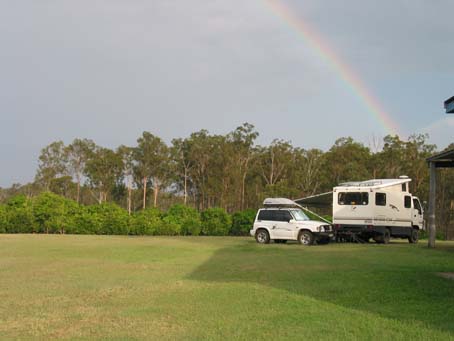
Here's view of the wideopen space available to set up your tent or your caravan - just after a sudden rainstorm which lasted only a few minutes before the sun came back and produced this rainbow over the mango trees. These are the smallish bush trees, between 3 and 5 metres high, in the middle foreground. Behind them are the much higher gum trees which cover most of this property. That's not our camp site by the way - it belongs to Jim and Joan, Kiwis both (i.e. New Zealanders) who rolled up after a couple of days, returned from a long journey to the very North of Queensland, Cape York. The rig is typical of what would be needed for bush camping in Australia: a 4WD truck with a camper section mounted un the truck bed, a "pop-top" to give headroom without adding to the driving wind-resistance, solar panels (about 100 watt) to give electric power for the refrigerator etc and a small 4WD drive vehicle in tow for side expeditions. They had used this smaller vehicle for the last 1000 km of the journey to Cape York, over the rough gravel roads which provide the only access route, unless you're prepared to head hazardlously across the open bushland. They told us that the road was so very bad in many places that this untracked route was very often preferable. Gertie II would not have been happy had we had any thoughts of this journey ! And here's a view of the same rig but before that epic journey and in company with a lot more campers....
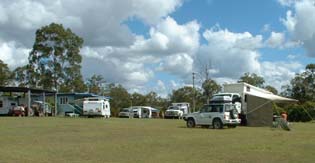
Adjacent to the present house was one of the original buildings on this property. About 150 years old, it would likely have belonged to a boundary rider, a cattle ranger in charge of many square miles of cattle. The little hut was built of resistant hardwoods and had had a few additions over its long life, each a mark of increasing comfort - the added-on kitchen, the added-on bathroom etc.
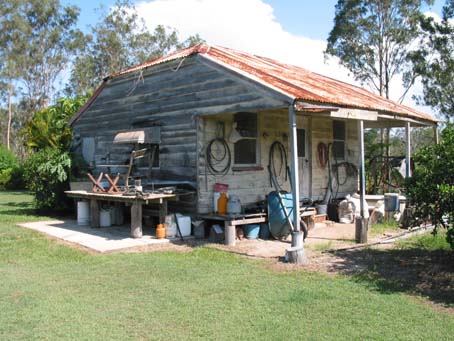
Both Rick and Aileen had been "bush people", not from the much wilder Gulf country, but sufficiently far from what we call civilization. Rick, indeed, at age 14 had been in charge of a 75 mile square property for periods when the owners were away, with only the weekly postman's visit and a telephone line hanging from the trees for its 60 mile length for company....We got into the habit of tagging along with Rick and Aileen during their 5:30 am walk around the property. Matilda and Kimberley came too. These were the two dogs. Matilda being quite old, it was about all she could manage, but she certainly relished the walk. Kimberley, much younger, bounded around in joy and sneaked surreptitiously off whenever possible to go for a cooling wallow in one or other of the dams, either on her own grounds or the neighbours', it was all the same to her, forbidden and so much more attractive. Dogs being the creatures they are, they were both uneasy when Rick and Aileen went off for their fortnightly shopping expedition to Bundaberg. Matilda wept and then Kimberley came to comfort her buddy while we reassured both that, no, they hadn't been abandoned. Kimberley, terrified by thunder and other sudden loud noises, came to hide beneath our van and then it was Matilda's turn to act as mother.....Here's a map of a few of the routes around the property - a full circuit would be about 3.5 km but a portion isn't easily accessible owing to the thick bush.
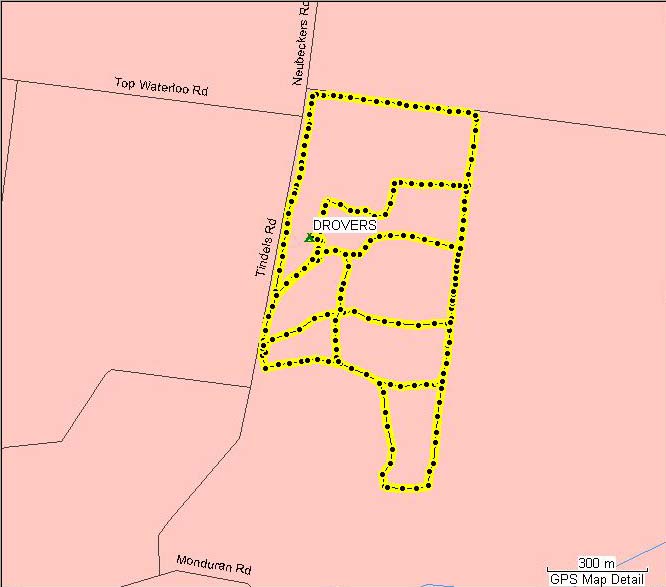
Some of the trails took us among the fruit trees but mostly they were well-marked tracks through the bush, gum trees and wattle. It's always a smart idea to provide frequent fire breaks in this country and particularly so at the boundaries because it's common practise to burn off the dangerously-inflammable bottom growth through which bush fires are transmitted. Mature gum trees themselves are resistant to such superficial fires (in fact, some varieties depend upon such fires to broadcast their seeds) but once a large fire gets hold of these large trees the resultant fire becomes disastrous. These things were well known to the Aboriginals, who made it a practice to regenerate the bushland by controlled burnings - the vcgetation beneath the mature trees rapidly regenerates and then gives herbiage for the animals they hunted for food.
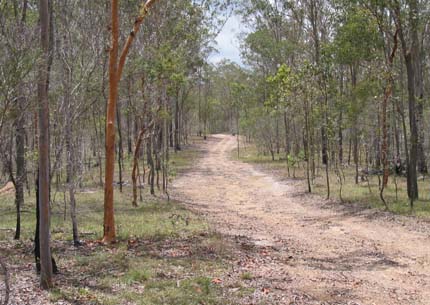
Here's a typical view along one of our walks. It looks as though there's been a fairly recent small burn through here, for a lot of the trees show the fire-blackening at the base which is so much a feature of this landscape. We've developed the habit of looking very carefully wherever we walk because of the possibility of stepping on a sleeping snake. Also, of treading heavily so as to advise any such creatures that we're around and so give them a chance to escape. We often saw snake and kangaroo tail trails in the dust (the snake trails are wiggly and don't have the paw prints on either side !). And, too, the occasional lizard or cane toad, that noxious creature introduced into Queensland to get rid of the sugarcane-infesting insects and now a pest in its own right. This ground may look dry and dusty here, but this year has so far been a good one for rains and the cattle we've seen so far don't have the emaciated appearance they did three years ago on our last visit. Drovers Hut has two or three bore holes providing reasonable water and a couple of dams pretty well full at the moment because irrigation isn't needed except for planting new trees.
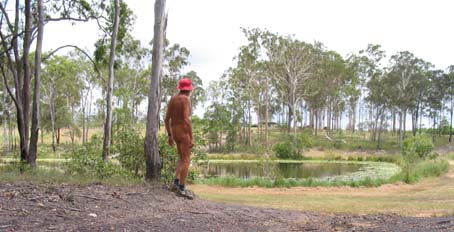
Beyond the dam are the mango and the citrus trees. And no doubt Kimberley is fossicking around amongst the water lilies to try and catch one of the frogs or a snake perhaps.Every morning we were awakened by a chorus of birds. Earliest of all were the Kookaburras with their maniacal laughter - nicest of all were the Butcher birds who seemed to take a half-hour or so first thing to develop the most complicated note sequence which then became their theme song for the day. Here's a picture of one of these songsters getting a feed of snake - it caught the snake by the head (risky business) and then bashed it to death on the tree before swallowing it whole (the snake, not the tree). If you feed the bird a sausage, by the way, it will bash that to death first in the same manner.
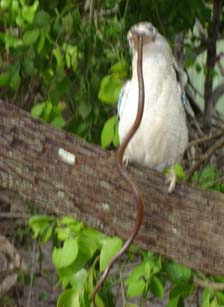
While on the topic of bizarre meals, recall the taste of "bush tucker" I mentioned a couple of weeks ago ? The oyster-like shell fish, called "pipi" we found out later, that we dug up on Fraser Island ? Frankly, I prefer my oysters cooked rather than raw and that is certainly the case for wichitti grubs. Sauteed with a little butter or even grilled over an open fire these are apparently tasty as well as very nutritious and it seems that you can eat them raw, too, at a pinch. Whether you can keep them down is another matter though.....
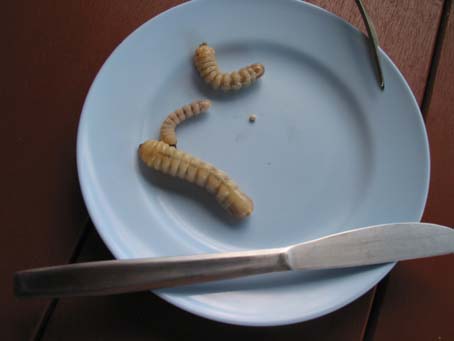
We learned of an encounter Rick had with a saltwater crocodile's nest while on a three-month camping trip along the Queensland coast. Discovering a salty's nest is one thing - returning to it is yet another - finding it's been disturbed and hanging around is quite a different matter. Apparently the adult croc will stick around in the vicinity when the eggs are about to hatch and of course to a croc anything that looks like food most certainly will be treated as such ! Notice the insect-proof gear in use here: the mozzies are even hungrier than the crocs.
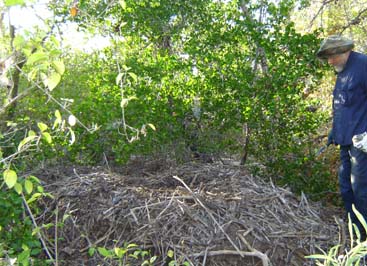
This is, after all, a working farm property and we learned a little of the hazards and the hard work associated with growing market-sensitive crops. The oranges and the limes weren't ripened but very many were subject to insect attacks, fungus and even plain bruising because of winds. Fruit fallen from trees encourages the growth of fruit flies and so ideally these shouldn't be left on the ground - at the very least, this fruit has to be sprayed clean, an expensive and time-consuming process.
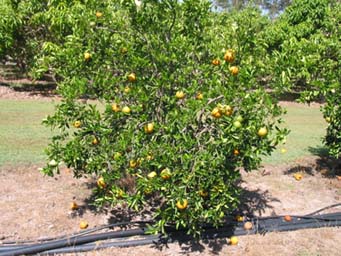 One of the orange trees
One of the orange trees
Mangos are equally demanding. The ripe fruit, we were surprised to learn, actually squirts out a corrosive fluid from the stem when picked and this juice has to be washed off before marketing. Fruit has to picked fresh and is stored in a large cold room before being shipped via agents to the larger urban centres for marketing. We sampled the mangos, not quite ripe as they were, and I'm afraid that the poor specimens we buy in the Ottawa supermarkets at ten times the price would simply be chucked onto the compost heap here.
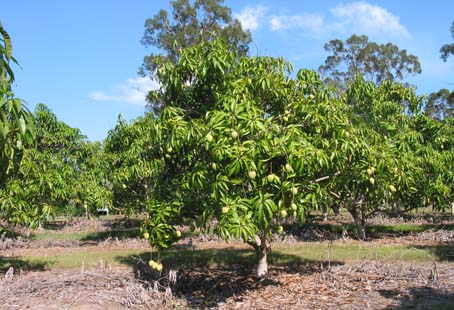 One of the mango trees
One of the mango trees


On the left, the male tree with the male fruit. On the right, the female tree with the female fruit.
The male tree has bunches of flowers and, perhaps appropriately, the fruit hangs on a long proboscis-type thingie whereas the female has single flowers and its fruit isn't quite so extrovert. Had we had the opportunity then we could have whipped up a batch of mango chutney (which requires a few pawpaws, papayas and such) to top off our barbequed lamb chops.Passion fruits grow upon vines and they are much in demand at this season - as everyone knows of course, passion fruit juice is the essential ingredient for creating a Pavlova, Australia's counter to the plum pudding for every christmas dinner. Passion fruit with mangos for breakfast..........
 Passion on the vine....
Passion on the vine....
 ....and the humble avocado...........
....and the humble avocado...........
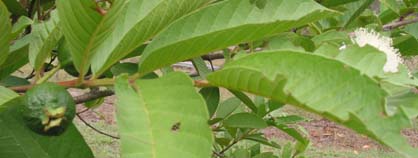 .....and the guava, too.
.....and the guava, too.
The guava tree carries beautiful white flowers (on the right above) and perpetually produces fruit at the same time (on the left above) so you never know really where you're at with this tree.
It's a bad thing to be dependent upon single crops when you're a farmer. This part of Queensland is heavily cropped with sugar cane and the farmers are totally dependent upon the highly automated sugar processing plants to make a living - crops are staggered over the whole growing year to keep the plants running continuously and livelihood depends upon this monopoly and of course upon world market prices. Nuts grow very well here: peanuts, macademia and cashew nuts being particularly well-paid crops so that farmers are tending to diversify towards these. Cashews are very fascinating fruits.
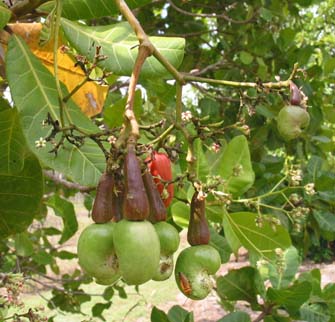
The fruit itself is the top portion in the examples above, green until ripe, then turning bright red and developing a beautiful aroma, darkening when overripe and finally dropping off the tree. But the nut is in the lower portion, looking a bit like a foetus or curled-up grub. Unfortunately, the nut is initially either poisonous or highly unpalatable and has to be scrubbed before opening the shell. It's not easy, either, to open a cashew nut because the nut meat is much softer and tougher than many nuts and so is the shell so that invariably you end up with a mess of mixed-up fragments. The secret, I understand, is to cool the nuts rapidly until the shell's brittle, tap them and so shatter the shell but not the inside. Sounds simple - we tried and the results were unimpressive and inedible. Nuts for the nutty sez I.
We stayed for a whole week with Rick and Aileen and during that time they made us feel very much at home. This is not your usual naturist resort - it has simplicity and friendliness, all the facilities you really need and is an ideal place to rest and recuperate. Take our recommendation and pay them a visit. Oh, and ask Rick for a taste of his home-made ale.......
As for us, we have to make our way South toward Port Macquarie for Xmas. But on the way, we'll call in at Running Bare Nudist Rural Retreat ( www.running-bare.com.au ), conveniently half-way there. See you soon.